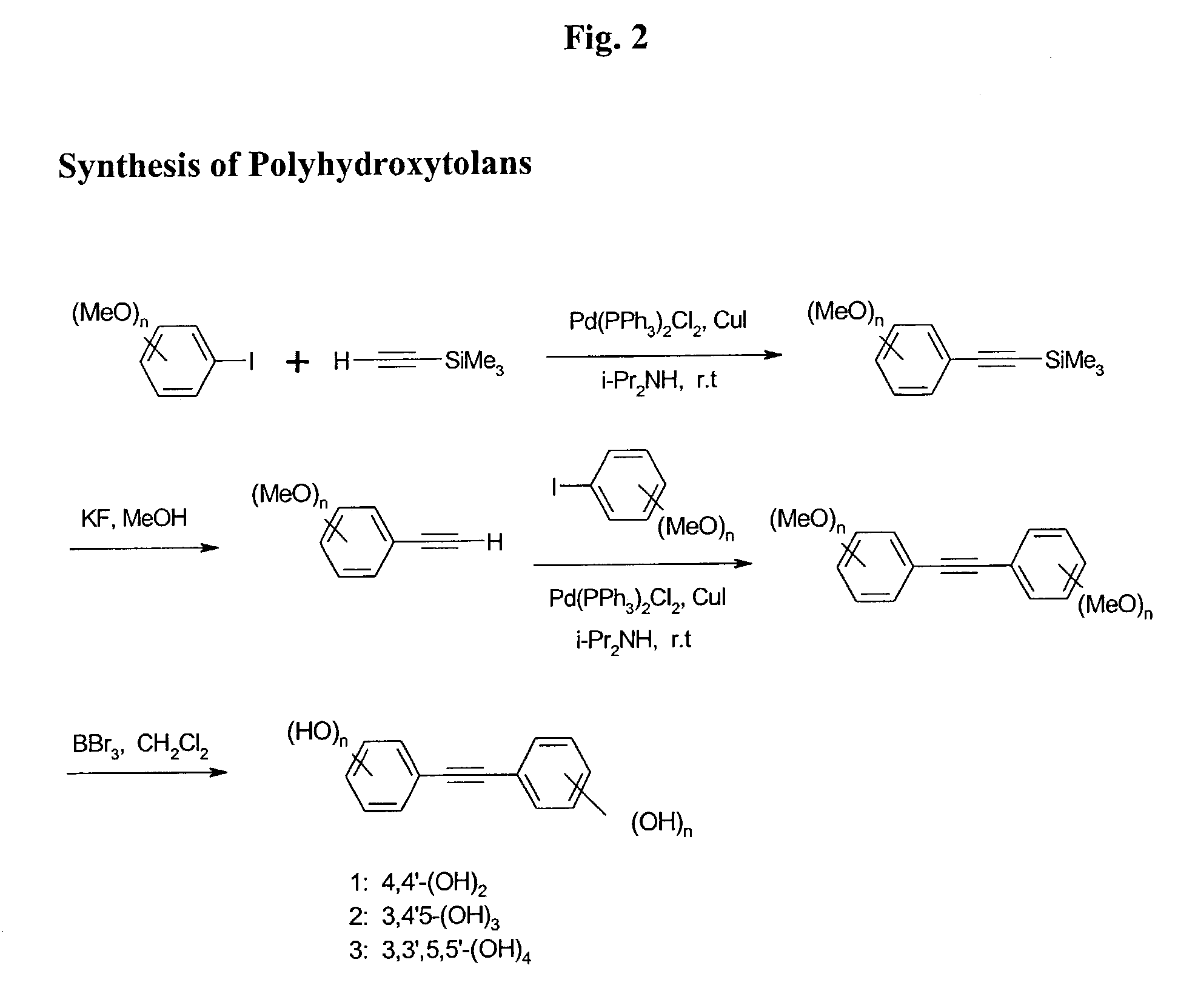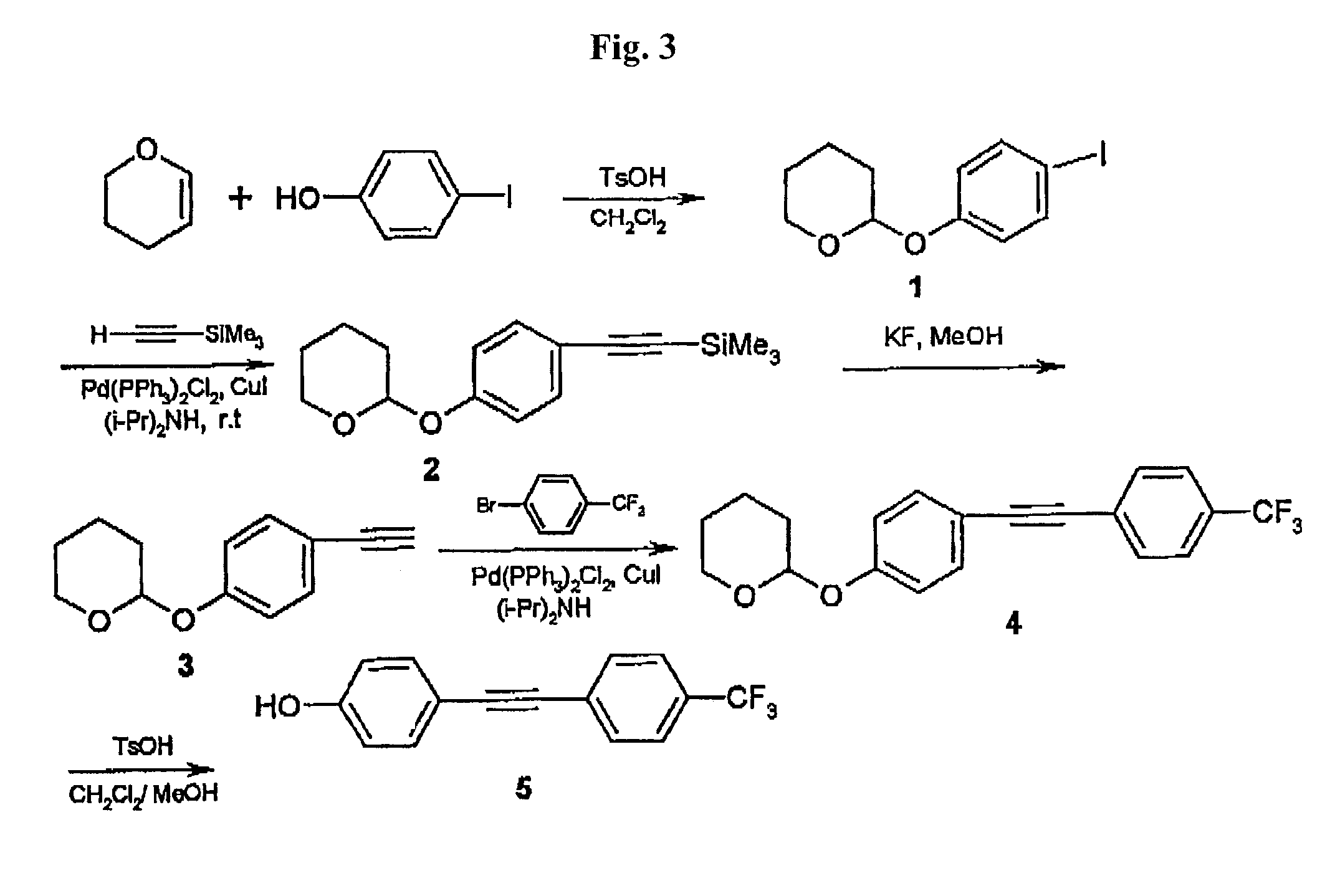Method of treating subject infected with Neisseria gonorrhea
a technology of neisseria gonorrhea and subject, which is applied in the field of treating subject infected with neisseria gonorrhea, can solve the problems of large infectious virus release, inability to eliminate all infectious hsv particles from the body of the afflicted individual, and inability to eliminate all infectious hsv particles, etc., to prevent the spread of herpes virus, reduce the cytopathic effect, and inhibit virus replication
- Summary
- Abstract
- Description
- Claims
- Application Information
AI Technical Summary
Benefits of technology
Problems solved by technology
Method used
Image
Examples
example 1
Synthesis of Poly-Hydroxylated Tolans
A. Synthesis of 3,5-dimethoxyiodobenzene from 3,5-dimethoxyaniline
[0046]In a 500 ml 3-necked, round-bottomed flask equipped with a thermometer, a mechanical stirrer and an addition funnel was placed HCl (12 M, 100 ml, 1.2 mol) and crushed ice (100 g). The flask was immersed in a dry ice-Me2CO cooling bath, and 3,5-dimethoxyaniline (15.3 g, 100 mmol) was added with stirring. To this cold mixture NaNO2 (8.4 g, 120 mmol) in 40 ml H2O was added dropwise at such a rate to maintain the temperature of the reaction mixture between −10˜−5° C. throughout the addition. The reaction mixture was stirred for 1 hour at 0˜5° C. The red dark solution of the diazonium salt was added to a well-stirred solution of KI (83 g, 500 mmol) in 200 ml H2O at room temperature. The mixture was stirred for 2 hours, then allowed to stand overnight. The resulting solution was extracted with ether (200 ml×4). The pooled organic extracts were washed with brine (200 ml×2), and an a...
example 2
Synthesis of 4-Hydroxy-4′-trifluoromethyltolan
[0081]FIG. 3 shows a synthetic scheme for the preparation of hydroxy-trifluoromethyltolan. Synthetic details of the specific reaction steps are described below. Most of the reactions were accomplished with high yields (over 90%). All products were purified by column chromatography and characterized by GC and 1HNMR spectrometry.
1. 1-Iodo-4-tetrahydropyranyloxybenzene 1.
[0082]To a stirred solution of 4-iodophenol (11.0 g, 50 mmol) in CH2Cl2 (50 ml) cooled with an ice bath, dihydropyran (5.0 g, 60 mmol) was added dropwise over 10 min at 0–5° C. After the solution became clear, toluenesulfonic acid, TsOH, (10 mg) was added. The solution was stirred at 20° C. for 15 min. Then it was quenched by addition of NaHCO3 (1 g) and 3 drops of water, and after stirring for 5 min at 20° C., the solvent was removed in vacuo and the residue was purified by column chromatography on silica gel with petroleum ether as eluent to give 14.0 g (92%) of 1 as colo...
example 3
Inhibiting Formation of Infectious HSV-1 Particles by Treatment with a Di-Hydroxylated Tolan
[0092]Cultures of African green monkey kidney cells (Vero) cells, obtained from the American Type Culture Collection, Rockville, Md. were grown to confluence in Medium 199 supplemented with 5% fetal bovine serum, 0.075% NaHCO3, and 50 μg / ml gentamycin sulfate in 25 cm2 tissue culture flasks. Cells were infected with HSV-1 at a multiplicity of infection (moi) of one and incubated at room temperature for one hour to allow for virus attachment to and penetration of the cell. Under these conditions, approximately half of the cells are infected with virus. Thereafter, the cultures were rinsed three time with media and incubated in medium containing 50 μM or 75 μM 4, 4′-dihydroxytolan prepared in 0.2% dimethyl-sulfoxide (DMSO). Controls were treated identically, but were incubated without the dihyroxylated tolan. For purposes of comparison, HSV cell were also inoculated in the presence of 52.5 μM 4...
PUM
| Property | Measurement | Unit |
|---|---|---|
| temperature | aaaaa | aaaaa |
| volume | aaaaa | aaaaa |
| temperature | aaaaa | aaaaa |
Abstract
Description
Claims
Application Information
 Login to View More
Login to View More - R&D
- Intellectual Property
- Life Sciences
- Materials
- Tech Scout
- Unparalleled Data Quality
- Higher Quality Content
- 60% Fewer Hallucinations
Browse by: Latest US Patents, China's latest patents, Technical Efficacy Thesaurus, Application Domain, Technology Topic, Popular Technical Reports.
© 2025 PatSnap. All rights reserved.Legal|Privacy policy|Modern Slavery Act Transparency Statement|Sitemap|About US| Contact US: help@patsnap.com



